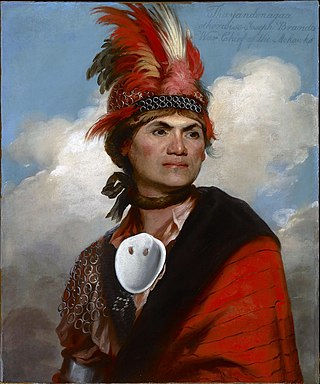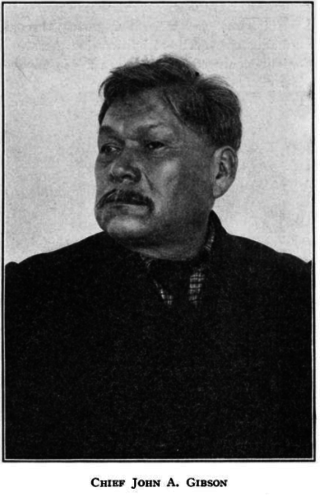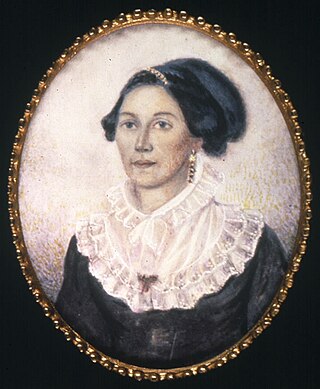Related Research Articles

Among the Haudenosaunee the Great Law of Peace, also known as Gayanashagowa, is the oral constitution of the Iroquois Confederacy. The law was written on wampum belts, conceived by Dekanawidah, known as the Great Peacemaker, and his spokesman Hiawatha. The original five member nations ratified this constitution near modern-day Victor, New York, with the sixth nation being added in 1722.

Thayendanegea or Joseph Brant was a Mohawk military and political leader, based in present-day New York and, later, Brantford, in what is today Ontario, who was closely associated with Great Britain during and after the American Revolution. Perhaps the best known Native American of his generation, he met many of the most significant American and British people of the age, including both United States President George Washington and King George III of Great Britain.

The Mohawk people are the most easterly section of the Haudenosaunee, or Iroquois Confederacy. They are an Iroquoian-speaking Indigenous people of North America, with communities in southeastern Canada and northern New York State, primarily around Lake Ontario and the St. Lawrence River. As one of the five original members of the Iroquois League, the Mohawk are known as the Keepers of the Eastern Door – the traditional guardians of the Iroquois Confederation against invasions from the east.
The Seneca ( SEN-ik-ə; are a group of Indigenous Iroquoian-speaking people who historically lived south of Lake Ontario, one of the five Great Lakes in North America. Their nation was the farthest to the west within the Six Nations or Iroquois League in New York before the American Revolution. For this reason, they are called “The Keepers of the Western Door.”

The Onondaga people are one of the five original nations of the Haudenosaunee (Iroquois) Confederacy in the Northeastern Woodlands. Their historical homelands are in and around present-day Onondaga County, New York, south of Lake Ontario.
Iroquois kinship is a kinship system named after the Haudenosaunee people, also known as the Iroquois, whose kinship system was the first one described to use this particular type of system. Identified by Lewis Henry Morgan in his 1871 work Systems of Consanguinity and Affinity of the Human Family, the Iroquois system is one of the six major kinship systems.

Handsome Lake was a Seneca religious leader of the Iroquois people. He was a half-brother to Cornplanter, a Seneca war chief.
The Haudenosaunee was formed around the Great Law of Peace Kaianere'kó:wa, a constitution detailing a shared value system which informs the policy and economics of their society.

The Treaty of Canandaigua, also known as the Pickering Treaty and the Calico Treaty, is a treaty signed after the American Revolutionary War between the Grand Council of the Six Nations and President George Washington representing the United States of America.
The Great Peacemaker, sometimes referred to as Deganawida or Tekanawí:ta was by tradition, along with Jigonhsasee and Hiawatha, the founder of the Haudenosaunee, commonly called the Iroquois Confederacy. This is a political and cultural union of six Iroquoian-speaking Native American tribes governing parts of the present-day state of New York, northern Pennsylvania, and the eastern portion of the provinces of Ontario, and Quebec Canada, recognized as sovereign by both the USA and Canada.
The Tonawanda Seneca Nation is a federally recognized tribe in the State of New York. They have maintained the traditional form of government led by sachems selected by clan mothers. The Seneca are one of the original Five Nations of the Haudenosaunee or Iroquois Confederacy. Their people speak the Seneca language, an Iroquoian language.

The Iroquois Tree of Peace finds its roots in a man named Dekanawida, the peace-giver. The legends surrounding his place amongst the Iroquois is based in his role in creating the Five Nations Confederacy, which consisted of the Mohawks, Oneidas, Onondagas, Cayugas, and Senecas, and his place as a cultural hero to the Haudenosaunee Nation, commonly known in Western culture as "Iroquois". The official title of the confederacy is, Kayanerenh-kowa as described by Paul A. Wallace, "it is also known as Kanonsionni, a term that describes both its geographical extent and its constitutional form". The myths and legends surrounding Dekanawida have the roots in the oral histories that followed many Native American tribes throughout their histories.

The Iroquois, also known as the Five Nations or the Six Nations and by the endonym Haudenosaunee, are an Iroquoian-speaking confederacy of Native Americans and First Nations peoples in northeast North America and Upstate New York. They were known during the colonial years to the French as the "Iroquois League", and later as the "Iroquois Confederacy". The English called them the "Five Nations", including the Mohawk, Oneida, Onondaga, Cayuga, and Seneca. After 1722, the Iroquoian-speaking Tuscarora from the southeast were accepted into the confederacy, which became known as the Six Nations.

Tadodaho was a Native American Hoyenah (sachem) of the Onondaga nation before the Deganawidah and Hiawatha formed the Iroquois League. According to oral tradition, he had extraordinary characteristics and was widely feared, but he was persuaded to support the confederacy of the Five Nations.

Jigonhsasee was an Iroquoian woman considered to be a co-founder, along with the Great Peacemaker and Hiawatha, of the Haudenosaunee (Iroquois) Confederacy sometime between AD 1142 and 1450; others place it closer to 1570–1600. Jigonhsasee became known as the Mother of Nations among the Iroquois.
The Onondaga Council governs the Onondaga Nation, a sovereign nation, one of six nations of the Iroquois people, that lives on a portion of its ancestral territory and maintains its own distinct laws, language, customs, and culture. The "nation" is not governed by a Council of Chiefs since the notion of federalism and proportional representation was strictly adhered to. After the dissolution of the League, interests lie only in external matters such as war, peace, and treaty-making to further the unanimity of the United States government. Since Tadodaho was appointed to the council fire and given weapons to protect the sacred fire within the house, the Grand Council could not interfere in the internal affairs of the tribe. Their role was limited to matters between themselves and other tribes; they had no say in matters that were traditionally the concern of the ability of the clan names.

John Arthur Gibson (1850–1912) was a chief of the Seneca nation of the North American Iroquois confederation. Part Onondagan and part Senecan, he resided within the reserve of the Six Nations of the Grand River in Ontario, Canada. Knowledgeable about Iroquois culture, he is best known for the versions he provided of the Iroquois oral constitution, the Great Law of Peace. He acted as an advisor to the Canadian Department of Indian Affairs in matters relating both to Iroquois and non-Iroquois indigenous people. He was a well-respected player of the traditional Iroquois sport of lacrosse until he was blinded during a game when he was 31.
Leon Shenandoah was an Onondaga politician who headed the Haudenosaunee (Iroquois) Confederacy from 1968 to his death.

The Royaner are the hereditary male clan leaders within the Haudenosaunee Confederacy. They are chosen by their respective Yakoyaner to represent their clan at the confederacy level. The specific name-titles held by the royaner belong to the matrilineal lineages headed by the clan mothers. These male leaders are expected to serve their community for life, although there are ways of removing a royaner if he does not live up to his lineage's expectations. With the clan mothers, the royaner form the hereditary leadership that distinguishes itself from the elected Band Council imposed by the Canadian state.

The Yakoyaner (also spelt iakoiane) is a Kanien'kehá:ka (Mohawk) term for the Haudenosaunee clan mother. The Yakoyaner are typically senior women responsible for overseeing the clan's political, economic, and social stability. The Yakoyaner, also known as a clan mother, holds weight over their community and family and aids in guiding the clan's chief in matters of governance, diplomacy, and community affairs.
References
- 1 2 3 4 5 “Government.” Haudenosaunee Confederacy, May 2, 2018. https://www.haudenosauneeconfederacy.com/government/.
- 1 2 Mann, Barbara; Johansen, Bruce Elliott (2000). Encyclopedia of the Haudenosaunee (Iroquois Confederacy). Greenwood Publishing Group. pp. 122–131. ISBN 978-0-313-30880-2.
- 1 2 3 4 Communications. "Current Clan Mothers and Chiefs". Haudenosaunee Confederacy. Retrieved 2023-07-18.